
Wine Culture and Information since 2002 - Volume 22
 Wine Culture and Information since 2002 - Volume 22 |
|
Issue 31, June 2005 |
Contents |
|
|
Wine and Cork: a Complex Subject |
|
It would be hard to believe, nevertheless in the world of wine that little element which is put on the top of a bottle - and having the function of sealing it - has a fundamental and strategical importance, last but not the least, cultural and traditional as well. There are so many arguments going on around that simple cork cylinder - or of any other material - most of the times giving less importance to what should be considered no matter the type of seal which is put in the bottle. Nevertheless, even though we all do not fully realize this, that seal often conditions our acceptance towards that wine which the seal should protect from the external dangers: in case the cork meets the expectations of consumer, it is more likely the wine contained in the bottle will be considered of higher quality as well. How can it be a little cylinder made of cork or of any other material - the closure - is capable of influencing the prejudice and the acceptability of wine in such an important way? According to the opinion of many consumers, it seems the cork plays an important role in the acceptability of a wine, according to producers, its role would be less important. By trying to be objective, without being influenced by cultural and prejudicial factors, we believe producers are right. We do not think it is enough closing a bottle with a high quality cork closure to make a wine better. In other words, a cork does not make a wine. Cork undoubtedly has fundamental importance in those wines destined for long aging periods in bottle, in which the essential exchange of air from the inside of the bottle to the outside is ensured by the characteristics of natural cork. The same is not so important in those wines destined to an immediate consumption, as the aging in bottle, not only is not recommended, it also worsen the organoleptic qualities of the wine. Moreover, whenever it is possible, it is always better to see a bottle with a good synthetic cork instead of a bad natural cork. According to the point of view of producers, it is absolutely essential a wine reaches the glass of consumers in the same condition it left the winery, with all of its organoleptic qualities being unaltered and unspoiled. In this sense, it certainly is not the cork the only factor allowing the achievement of this goal: a wrong service temperature, wrong glass, bad keeping of wine, are all elements equally important playing a fundamental role in the appreciation of a wine. This includes the cork as well, of course. In fact, it is enough the cork is faulty, both because it has been damaged by the effects of tricloroanisole - also known as TCA or corky smell - as well as because of an insufficient tightness, the wine, even in the most appropriate serving conditions and keeping, does not express its best qualities. If it is true consumers have accepted with no problems the introduction of the most innovative technologies in the production of wine - while recognizing their fundamental role in the production of quality wines - the technological progresses made by the closure industry seem to have a lesser acceptability. If we consider the now very common statistical figures which everyone knows, 4-5% of wine bottles are damaged by the effects of the trichloroanisole spoilage in natural cork closures, with the consequence of the well known and disgusting corky smell. Moreover, to these figures must be added about a 10% of wines that, because of an insufficient tightness of natural cork closures, get prematurely oxidized therefore damaging the wine. If we consider these figures, the loss because of accidental factors caused by corks is not irrelevant. This does mean in a production of 100,000 bottles, there is a loss of more than 10,000 bottles of wine. This loss, undoubtedly, also affects the price of wine: it is evident this loss represents an increasing in costs for producers. The solutions proposed to these kind of problems include the well known synthetic corks - which are not completely accepted by consumers yet - as well as the most recent introduction of screwcaps, used since a long time in ordinary and bulk wines, soda pops and mineral waters. If it is true synthetic corks suffer from a strong resistance by consumers, for most of them screwcaps are even considered unacceptable. The results of studies about this subject, ensure these kind of closures allow a better keeping of the freshness and the integrity of aromas and flavors of wines in which are being used: a factor that should grant them a better acceptability and preference. However it is undeniable the better tightness of these corks accelerates reductive processes, and in just 18 months the quality of wines is seriously compromised. This latter consideration should suggest not using synthetic corks or screwcaps in wines destined to long aging in bottle. This is what producers know as well and - in fact - they make use of synthetic corks and screwcaps in wines destined to an immediate consumption, such as whites, roses and young reds. It is not an economic matter only: it is undeniable it is the primary interest of producers to ensure their products the best consumption conditions possible. This should be the interest of consumers as well. Nevertheless the closure is still a complex and delicate subject, which irritates consumers when they see a bottle sealed with a synthetic cork. It is such a delicate subject which could make one thinks the wine contained in the bottle is less important and it seems to be the cork what it is being poured in glasses. Of course, it is also something associated to tradition and culture. Anyway, does it really make sense - in the sake of tradition - allowing the spoilage of a wine when it can be avoided? It is also true a screwcap deprives the consumers of the enjoyable ceremony of the opening of a bottle made of corkscrews and cares: a simple and quick movement and the wine is ready to be poured in a glass. Anyway, this is a cultural barrier very hard to change. Despite the efforts of producers in having these closures accepted, many consumers still have the prejudice synthetic corks and screwcaps are used in low quality wines. A cultural change hard to achieve, saved the case consumers will begin to pay more attention to what it is being poured in their glasses instead of paying attention to what they see in a bottle. After all, the attention paid to the cork is limited to the time in which the bottle is being uncorked: the pleasure of the appreciation of a wine has a truly longer time, no matter the closure is made from natural cork or any other synthetic material.
|
||||
MailBox |
|
In this column are published our reader's mail. If you have any comment or any
question or just want to express your opinion about wine, send your letters to
our editorial or fill in
the form available at
our site.
|
| My compliments for your interesting publication, every month rich in interesting things to learn for us wine lovers. I often hear talking about “all purpose meal wines” and I personally believe it is pretty hard to find a wine which can be matched to every food of a meal. I would like to know your opinion about this subject and, if possible, to know the types of wines which can be used for this purpose. |
| Annamaria Gregori -- Bologna (Italy) |
| The definition all purpose meal wine is pretty vague and most of the times inappropriate as well. If we consider, for example, a meal in which are being served a soup and a roast, it is pretty hard to find a wine which can meet objective requirements for a good match with both foods. Whether for the soup we could choose a white or a rose wine, this wine will be hardly matched to the roast, saved some cases in which it is roasted white meat. The same problem is true in case it would be chosen a bodied red wine to be matched to the roast with the consequence of penalizing the soup which would be covered by the personality of the wine. Indeed the term all purpose meal wine means a wine suited for a non excessively elaborated meal or however made of pretty similar foods both for nature and preparation. Most of the cases this term is used to refer to a wine capable of satisfying, even though with some exceptions and compromises, the usual needs for meals consumed every day. By obeying to the common saying In Medio Stat Virtus (the virtue is in the middle), the best all purpose meal wines would probably be roses: they have more body than whites and less body than reds, therefore more suited for this compromise as they generally offer good freshness, good aromas and “enough” structure. |
| I read in your magazine brandies should not be served in balloon glasses as they excessively exalt alcohol. Moreover I read the habit of warming a distillate with a flame should be avoided as well. As these two habits are not advisable, why do they keep on serving brandies this way? My compliments for your publication. |
| Philip Baker -- Chicago, Illinois (USA) |
| Serving a distillate in a balloon glass means, first of all, to excessively exalt the volatile and ethereal quality of alcohol while penalizing the development of all other aromas. Alcohol is a highly volatile element and it does not certainly need high quantity of oxygen in order to develop. Warming a distillate with a flame before its consumption, could develop burnt aromas and tastes because of high temperature. Moreover, warming a distillate with a flame excessively develops the ethereal character of alcohol with the result of making the distillate pungent during the evaluation of aromas: a condition which can also cause an unpleasing and painful reaction. The reason why distillates are often served this way should be found in traditions and in those habits now commonly accepted and believed to be right. Also thanks to improved distillation and aging techniques, distillates generally have now a higher finesse and a better organoleptic quality, as to require the use of more modest sized glasses capable of exalting the elegant and refined characteristics of aromas. If we consider the modern Cognac glass - a tulip shaped glass of small size - it can be understood how the tasting of this distillate has developed over time. In fact the classic balloon glass was traditionally associated to Cognac in the past and it represented an indisputable rule for its service. Today connoisseurs avoid using this type of glass and prefer the more suited tulip shaped glass. |
Loire ValleySauvignon Blanc and Chenin Blanc are the most important grapes of this French wine region, famous for its white wines, as well as for Cabernet Franc, the main grape in red wines |
|
According a wine making point of view, Loire Valley is one of the most interesting wine regions in France. Besides being extended on a pretty wide territory with different environmental characteristics - Loire Valley is among the largest wine regions in France - here are being produced many wine styles, from whites to reds, from roses to sparkling wines as well as sweet wines. Loire Valley is mainly known in the world for the production of white wines, and in particular the ones produced with Sauvignon Blanc and Chenin Blanc grapes, however the production of red wines is interesting as well, in particular the ones from Cabernet Franc and Gamay grapes. Loire Valley is also renowned for another white wine, produced in the western area of the region, around the city of Nantes: Muscadet. This wine - usually appreciated for the matchings with crustaceans - represents the main production in terms of quantity and it is produced with Melon de Bourgogne grape, here known as Muscadet. The territory of this wine region goes along the course of Loire river, the longest in France. The first wine area of Loire Valley is located in the beginning of the river - west from Burgundy - and going towards north, still along the course of the river and near the city of Orléans, are found other wine areas, pretty distant one from another. When the course of the river arrives near the cities of Nevers and Bourges, then arriving to the city of Orléans, where it angles towards west and continues its course towards the Atlantic ocean, begins the most important wine area of Loire Valley, the area from which comes the most important wines of the region. It is right in these areas - proceeding to the western part near the Atlantic ocean - are being produced the most important wines of Loire Valley such as Sancerre, Pouilly-Fumé, Vouvray, Savennières, Quarts de Chaume, Montlouis, Chinon, Bourgueil, Menetou-Salon and Muscadet. The wines of Loire Valley - as opposed to other French wine regions - are distinguished for the variety with which are being produced: whites, roses, reds, sweets and sparkling wines, these all are wine styles which can be found in the areas of this region.
Despite the wine styles produced in the Loire Valley are many, the region is however particularly associated to whites, certainly the most famous style in the world also thanks to the quality of the territory and of the grapes used for their production: Sauvignon Blanc, Chenin Blanc and Melon de Bourgogne. Of the three, Sauvignon Blanc certainly represents the celebrity of Loire Valley: the wines produced with this grape in this region are usually considered the reference model in all the wine areas of the world in which the grape is cultivated. In recent times Muscadet is being revaluated as well - the famous white wine produced with Melon de Bourgogne grape in the area near Nantes and the Atlantic coast - which represents, in terms of quantity, the most produced wine in the Loire Valley. The region's climate is pretty cool and the temperature often reaches pretty low values, almost to the limit of surviving for vines. In warm years, when the bunches of grapes receive a better exposure to sun rays, wines of this region can express their best condition, also thanks to the low temperatures ensuring their typical acidity. Because of the particularly rigid climate, in the years in which cold temperature and rains are frequent, the quantity of sugar in berries is particularly low and therefore wines have little alcohol and little body. For this reason, in these years producers of Loire Valley are allowed to add sugar to the must in order to increase the production of alcohol as well as to give more body to the wine. Chaptalization - despite it is frequently practiced in the northern and cool areas of France - is usually done in low quality and value wines, whereas serious and reliable producers hardly make use of this method saved in exceptional cases and in particularly bad years. Despite wines from Loire Valley are usually characterized by acidity and freshness of grape's aromas, since about twenty years it is getting more and more common the practice of fermenting and aging white wines in barriques, with the result of making more robust wines and with evident toasted qualities, very different from what can be considered the classic style of the region. The main white berried grapes of the Loire Valley include Sauvignon Blanc, Chenin Blanc, Melon de Bourgogne, Arbois, Chardonnay and Folle Blanche. Among red berried grapes are included Cabernet Franc, Gamay, Grolleau, Pinot Noir, Cabernet Sauvignon, Malbec (here known as Côt), Pineau d'Aunis and Pinot Meunier.
|
||||||||
|
Loire Valley is among the largest wine areas of France and it is recognized by the French quality system as AOC (Appellation d'Origine Contr˘lée, Appellation of Guaranteed Origin). According to a wine making point of view, the most important area in Loire Valley is the northern one, ideally divided into three areas. In the western part, near the Atlantic coast and around the city of Nantes, is found the production area of Muscadet, in the middle part are found the areas of Anjou-Saumur and Touraine, whereas in the eastern part, south from the city of Orléans, are located the production areas of Sancerre and Pouilly-Fumé. Whereas the production in the two external areas is oriented to white wines, in the middle part the production is very rich and makes different styles, from whites to reds, from roses to sparkling wines as well as sweet wines of rare elegance produced with grapes affected by Botrytis Cinerea. In the southern part, the one located west from Bourgogne, the production is about white, roses and red wines. Finally, in the Loire Valley is found a large production area of Vin de Pays - among the largest in France - and classified with the Vin de Pays du Jardin de la France appellation.
|
|
The areas south from Orléans, up to the cities of Bourges and Nevers, are called “central vineyards”. The reason of this name is not because the area is located at the center of Loire Valley, but at the center of France. The main grape in the vineyards in this region is Sauvignon Blanc with which are produced among the best wines of the world and in particular in the appellations of Sancerre and Pouilly-Fumé, considered as the reference model in other production areas. Sauvignon Blanc wines from this region express organoleptic characteristics like in no other part of the world, with aromas of flint, vegetal as well as smokey, a quality which determined the name with which Sauvignon Blanc is usually known in these lands: Blanc Fumé. In this area Sauvignon Blanc - also thanks to a particularly cool climate - expresses a pretty high acidity which contributes to the finesse and elegance of these wines. Despite the grape is used for the production of white wines in the whole region, the best Sauvignon Blanc examples are represented by Sancerre and Pouilly-Fumé. Sancerre is located in the western bank of the Loire river and the production of wines is extremely interesting. In the Sancerre area are found very good vineyards - with soils made of chalk and flint sediments - and the best ones are Le Grand Chemarin, Chêne Marchand and Clos de la Poussie. In the eastern bank of Loire river is found the city of Pouilly-sur-Loire, renowned for the production of Pouilly-Fumé. Soils in this area are rich in limestone, a characteristic believed to be responsible for the strong smokey aroma of the wines produced here. The enological techniques used in this region favor the keeping of freshness in wines, therefore the traditional method consists in the vinification in inert containers, such as cement and stainless steel. In the 1980's some producers introduced the use of barrique in order to increase the complexity and the body of wines, therefore obtaining results appreciated by many as well as disliked by others because too distant from what it is being considered the classic model of Loire Valley. Other production areas of this region include Menetou-Salon, Quincy and Reuilly, all being oriented to the production of white wines with Sauvignon Blanc. The only area in which are being produced red and roses wines is Sancerre in which are exclusively used Pinot Noir and Gamay grapes.
|
||||
|
Going towards west, is found the wine area of Touraine in which are being produced white and red wines. The climate of this area offers good conditions for the cultivation of red grapes that in Touraine means Cabernet Franc. The most renowned areas for the production of red wines are Chinon, Bourgueil and St.-Nicolas-de-Bourgueil. Red wines from Touraine are generally produced with 100% Cabernet Franc or Gamay, however in many cases are also used Cabernet Sauvignon, Malbec (Côt), Pineau d'Aunis and Grolleau. The most renowned white wines in Touraine are the ones belonging to the Vouvray appellation. Here it is Chenin Blanc to play the main role in vineyards and the white wines of this area are exclusively produced with this grape. Another interesting appellation - although less known than Vouvray - is Montlouis, whose wines are being produced with Chenin Blanc only. Wines from Vouvray represent the highest expression of Chenin Blanc produced in many styles, from dry to sweet made with grapes affected by Botrytis Cinerea, as well as sparkling wines. The climate of Vouvray is pretty cool and this allows to keep a pretty high level of acidity in grapes as well as giving a very good balance in sweet wines that, with a proper aging, get extraordinary organoleptic qualities.
|
|
The wine area of Anjou-Saumur is among the most interesting ones of the Loire Valley for the variety of styles. Here the production is virtually about every style, including sparkling and sweet wines. In this area are mainly produced rose wines, however white is the most known style, in particular the wines belonging to the Savennières appellation. Here, as well as in Touraine, the white grape protagonist in vineyards is Chenin Blanc, with which are probably produced the best expression of wines in the world. Thanks to the particular environmental and climate conditions, here Chenin Blanc is capable of giving wines with a pleasing minerality, freshness and complex aromas like in no other place of the world and it can also stand to tens of years of aging in bottle. Anjou-Saumur is also a famous area for the production of sweet wines, that in favorable years, thanks to the development of Botrytis Cinerea or noble rot, reaches superlative levels of elegance. Once again, the grape responsible for the production of these wonderful wines is Chenin Blanc. The best sweet wines of Anjou-Saumur are from the appellation of Quarts de Chaume, a pretty small area however capable of producing extraordinary wines. The secret of these wines is represented by acidity that reaches levels such to perfectly balance sweetness, to which is also added the complexity of aromas and tastes provided by Botrytis Cinerea. Other excellent sweet wines in this area are from Bonnezeaux, Coteaux de Layon and Coteaux de l'Aubance appellations. One of the main wines produced in this area is Rosé d'Anjou, mainly produced with Grolleau grape to which is often added Cabernet Franc, Cabernet Sauvignon Côt (Malbec), Pineau d'Aunis and Gamay. Simple wines and basically sweet, as opposed to Rosé de Loire - produced with the same grapes - which is always dry. Red wines in this area are mainly produced with Cabernet Franc, Cabernet Sauvignon and Gamay, alone or assembled. The Anjou-Saumur area is also famous for the production of sparkling wines. The best examples are produced in the Saumur area, all being obtained with classic method and belonging to the appellations of Saumur and Crémant de Loire. The appellation of Saumur can be produced with Chenin Blanc, Chardonnay and Cabernet Franc grapes, whereas Crémant de Loire is mainly produced with Chenin Blanc and a part of Chardonnay and Cabernet Franc. Despite producers rarely use them, these sparkling wines can also be produced with Sauvignon Blanc, Cabernet Sauvignon, Côt (Malbec), Gamay, Pinot Noir, Pineau d'Aunis and Grolleau grapes.
|
|
A not very known wine but however representing the main production in terms of quantity in the Loire Valley. Muscadet is produced in the large area around Nantes, not very distant from the Atlantic coats. Muscadet is a relatively simple wine and produced with Melon de Bourgogne grape, locally called Muscadet. The best examples of this wine come from the Muscadet de Sèvre-et-Maine area, a district which is named after the two homonymous rivers of the area. Muscadet generally is a simple and immediate wine, famous for the matchings with crustaceans and seafood. In order to increase the complexity and structure of this wine, in the 1970's and 1980's many producers began aging Muscadet sur lie - that is on its lees and yeast - a practice which, in fact, makes the wine more interesting. Today are usually produced both styles, however the most common is sur lie, generally written in the label. The fermentation of Muscadet is generally done in steel tanks, however some producers also make use of casks with different sizes even for aging. Finally, in the same production area of Muscadet, is also produced Gros Plant, a light bodied wine obtained with Folle Blanche grape.
|
White Aromatic GrapesWith a comparative tasting, let's discover two aromatic grapes, Gewürztraminer and Sauvignon Blanc, by comparing them with a non aromatic grape, Chardonnay |
|
Studying the organoleptic qualities of wines and of grapes by using a comparative tastings is extremely useful for the development of any taster's skills. An useful exercise for the wine lover who is getting into the amazing world of sensorial analysis, is the study of aromatic grapes. The capacity of recognizing the typical qualities defining the so called aromatic grapes, allows the taster to learn the differences from non aromatic grapes, therefore making simpler their recognition in wines. The tasting we are proposing our readers this month has the goal of studying two aromatic grapes - Gewürztraminer and Sauvignon Blanc - by comparing them with a non aromatic grape - Chardonnay - in order to understand the differences and qualities defining an aromatic grape. Of all the three grapes, the only one which can be really considered aromatic is Gewürztraminer, whereas Sauvignon Blanc - despite the fact it has a strong aromatic quality - is considered as semi aromatic, and Chardonnay belongs to the family of non aromatic grapes. The choice of these three grapes was made according to the different families to which they belong to, in order to clearly understand their olfactory qualities by comparing the aromatic intensities of the three grapes. Before beginning our tasting, it is good to remember the meaning of aromatic grape. Despite all grapes have their own aromas, are being considered as aromatic only those grapes whose wines are characterized by a strong and evident aroma of grape. For this reason Muscat Blanc is considered an aromatic grape - the grapey aroma in its wine is very strong - whereas Trebbiano Toscano is not. In wines made with Trebbiano Toscano will be found other aromas, but the one of grape will not certainly be present, and other aromas defined as primary will be absent as well. The first goal of this tasting is to understand this aroma and to recognize its presence, or absence, in all the three wines.
|
|
The three wines we will be using in this comparative tasting are being produced with the three grapes only, that is are mono varietal wines. In order to better understand the qualities of the grapes, the wines we have chosen have been fermented and aged in inert containers, in this case steel tanks. The choice of three wines fermented or aged in cask - or barrique - would have not been appropriate for the goal of our tasting as the aromas passed from wood to the wine would have covered in a more or less evident way the natural qualities of grapes. Moreover, it is appropriate to remember the area of origin of the three wines will play a role in the organoleptic perception, and the same is true for the enological practices used in the production. In case it is not possible to use the three wines we are suggesting, you can alternatively choose wines produced with the same grapes, possibly from the same areas and - in particular - vinified in inert containers, such as steel or cement.
The first wine, the one we will use as the main reference point for understanding the primary aroma of grape, is Cantina Produttori Bolzano's Alto Adige Gewürztraminer Kleinstein. An excellent Gewürztraminer wine that, besides having the typical aroma of grape, has also an excellent number of aromas typical of this variety. The second wine is Scubla's Colli Orientali del Friuli Sauvignon, a wine that, besides having the primary aroma of this grape, will also allow the study of the typical vegetal characteristic of this variety. The third wine we have chosen for the tasting is Casale del Giglio's Chardonnay, interesting for its organoleptic qualities of tropical fruit and that will be compared with the ones of the other wines. In this third wine, the primary aroma of the grape will not be found and therefore, thanks to comparison, it will allow us to better recognize this aroma in the other two wines. As for vintages, it will be chosen - for all the three wines - the most recent one. The tasting will be done by pouring the wine in three ISO tasting glasses and served at a temperature of 10° C (50° F).
|
||||||||
|
Poured in the glasses, the three wines will look very different one from another. The aspect of all the three wines is crystalline and very transparent - just like we would expect from any white wine - whereas the color offers many possibilities for comparison and study. The three samples show very different colors and nuances. Of the three wines, the one showing a paler color will be Sauvignon Blanc and it is right this wine the first one we are going to analyze. The color of this wine is intense greenish yellow and - by tilting the glass over a white surface - we will notice, on the edge of the liquid mass towards the opening, nuances of greenish yellow. The first element we get from observing this aspect is that Sauvignon Blanc wines fermented and aged in inert containers - steel or cement tanks - do not have intense colors: a quality which is absolutely correspondent to the type and that we can see in this wine from Scubla. The next wine we are going to analyze is Casale del Giglio's Chardonnay. As opposed to Sauvignon Blanc, the hue of this wine shows a straw yellow color and, by tilting the glass, it will be noticed greenish yellow nuances on the edge, similar to Sauvignon Blanc's color. Even in this case the color is perfectly correspondent to the production style and to the type of containers used for vinification. Finally, let's observe the color of Produttori Bolzano's Gewürztraminer Kleinstein: the color has more intense and stronger hues and the nuances are more deep with a straw yellow color. Even in this case the color is perfectly correspondent to wines produced with Gewürztraminer and that in many cases - according to the territory and to the meteorological conditions - it can also show deep golden colors. It this examination it is better to compare the three glasses by placing them against a white surface and by observing the color variations according to the type of grape. Sauvignon Blanc gives wines with paler color, Chardonnay gives colors of average intensity, whereas Gewürztraminer produces wines with more intense colors.
|
|
The olfactory analysis of the three wines is the most interesting examination and offers the best opportunities for our study. The first wine we are going to analyze is Gewürztraminer. We will try to understand and identify - first of all - the strong aroma of grape, typical in aromatic grapes and that in Gewürztraminer is very strong. In this phase it is best not to swirl the glass in order not to have all the other aromas develop and that would represent a “disturbing” factor. Without swirling the glass, slowly smell the wine: the aroma having the stronger intensity and that will be perceived to the nose will be the one of grape, that is the quality defining Gewürztraminer as aromatic. Then smell again the wine - even by swirling the glass - in order to memorize this aroma. After a short pause, we will analyze the Sauvignon Blanc: it will be noticed, among other aromas, that in this wine is present - even though with a weaker intensity - the aroma of grape already perceived in Gewürztraminer. After a short pause, it will be done the olfactory analysis of Chardonnay: in this wine the aroma of grape will be absent. The three grapes we are using in our examination also offer other opportunity for study thanks to their aromatic analogies and differences. If we consider their aromas as a whole, the three wines offer three completely different aromatic bouquets. Gewürztraminer, besides its strong grape aroma, is also rich in fruit, floral and even spicy aromas. It is not by chance - of course - that gewürz in German means spicy. Sauvignon Blanc has a completely different nature: here strong aromas of vegetal essences are melt with perceptions of fruits and flowers. Chardonnay - which we will be basically using as a “contrast” grape - offers aromas of fruits, even tropical fruits, and flowers. Let's concentrate our attention on tropical fruit aromas, present in all the three wines. Gewürztraminer has aromas of litchi, pineapple and grapefruit, Sauvignon Blanc will reveal aromas of banana and litchi, whereas Chardonnay will develop aromas of banana and litchi. Compare the three wines while trying to identify the aromas of tropical fruits and the different intensities and nuances in every sample. Sauvignon Blanc offers good elements of study which are completely absent in the other two wines. Among the many and pleasing aromas, in the Sauvignon Blanc it is possible to perceive a strong aroma of bell pepper and tomato leaf, aromatic qualities which are absent in the other two wines. These aromas represent - as a matter of fact - identifying qualities for many Sauvignon Blanc wines, in particular the ones produced in cool climate areas or with not completely ripe grapes. Even the aromatic series of flowers is interesting: in Gewürztraminer will be perceived a pleasing aroma of rose - typical in this grape - as well as hints of elder flowers. Even in Sauvignon Blanc will be found the aroma of elder flower, here being more intense, that will be absent in Chardonnay, where they will be found aromas of acacia and hawthorn. Finally, it is interesting to pay attention on peach, apple and pear aromas, common in all the three wines. It is good to remember the peach aroma is frequently present in all aromatic and semi aromatic grapes. Whether Sauvignon Blanc can be recognized for its vegetal quality, Gewürztraminer can be identified - besides the primary aroma of grape - for its pleasing aromas recalling spices and aromatic herbs, such as star anise and sage.
|
||||
|
The goal of this examination is to compare the gustatory sensations of the three wines and - in particular - the differences among structures. The first wine we are going to analyze is Chardonnay: despite it has a higher structure than Sauvignon Blanc, in this specific case it is appropriate to consider the intensity and the variety of aromas as well as the alcoholic volume. Taste a sip of Chardonnay: the first sensation perceived in the mouth is its pleasing crispness, a quality which is also determined by its young age. Let's now pay attention on the wine's structure: a good method is to have the tongue sliding on the palate and to evaluate friction; the lesser the friction - therefore the easier the tongue will slide - the greater the presence of solid substances and therefore the greater the structure. Consider, as an example, the sensations caused by water and milk: with water the friction is pretty high, whereas with milk is low. The structure of this wine is to be considered average with a good roundness and flavors are pretty intense; it will be noticed a good correspondence to the aromas already perceived to the nose, in particular banana, peach and pear. Let's taste now Sauvignon Blanc: the friction of the tongue is higher, a condition caused by a lesser structure, a typical quality in this grape. On the contrary, it will be noticed a higher crispness and a higher intensity of flavors: even in this case, these are typical organoleptic qualities of Sauvignon Blanc. There will be perceived strong flavors of peach, pear and litchi. Then it will be tasted Gewürztraminer: in this case the structure is higher and it will also be noticed a higher burning sensation of alcohol while noticing a good acidity as well. Even in this case these are typical qualities of Gewürztraminer, a grape rich in sugar and therefore capable of producing higher quantities of alcohol as well as higher structures. During the tasting of Gewürztraminer it could be perceived a certain sweetness: this is a false perception which is determined by its high roundness - or smoothness - that will make the wine taste sweet or basically sweet; indeed the wine is absolutely dry. There will be noticed very intense flavors corresponding to the nose, in particular flavors of grape, peach, litchi and pear.
|
|
The taste-olfactory persistence in the wines will be different in all the three cases and with different intensities. Chardonnay will be the wine having the shortest persistence, whereas Gewürztraminer will have the longest persistence. It is good to remember aromatic grapes, when vinified with quality criteria, generally have very long taste-olfactory persistence. The flavors of Chardonnay in the mouth will be of banana, peach and pear, whereas Sauvignon Blanc will have flavors of peach, pear and litchi as well as hints of grape. In Gewürztraminer the flavor of grape will be pretty strong and long which will be fused with the ones of peach, pear and litchi: an interesting analogy with Sauvignon Blanc. Whereas it is possible to find some organoleptic analogies between Gewürztraminer and Sauvignon Blanc, Chardonnay - the wine used as a contrast element - will have pretty different organoleptic qualities, in which the typical characteristics of aromatic grapes will be absent. The only exception is represented by the aroma of peach which, it should be remembered, is not always found in Chardonnay wines vinified in inert containers.
|
Wines of the Month |
|
|
|
Score legend Prices are to be considered as indicative. Prices may vary according to the country or the shop where wines are bought |
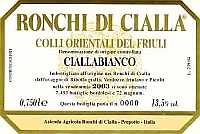
|
|
Colli Orientali del Friuli Cialla Bianco 2003 |
|
| Ronchi di Cialla (Italy) | |
| Grapes: Ribolla Gialla (60%), Verduzzo Friulano (30%), Picolit (10%) | |
| Price: € 13.00 | Score: |
| This wine shows a brilliant golden yellow color and nuances of golden yellow, very transparent. The nose denotes intense, clean and pleasing aromas which start with hints of apple, plum and almond followed by aromas of acacia, hawthorn, jasmine, broom, pear and hints of vanilla. In the mouth has good correspondence to the nose, a crisp attack and however balanced by alcohol, good body, intense flavors, agreeable. The finish is persistent with flavors of plum, pear and almond. Cialla Bianco ages in barrique for 11 months followed by 6-12 months of aging in bottle. | |
| Food Match: Fish and crustaceans appetizers, Vegetables soups, Eggs, Sauteed fish | |
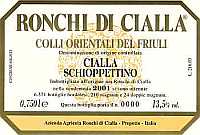
|
|
Colli Orientali del Friuli Schioppettino Cialla 2001 |
|
| Ronchi di Cialla (Italy) | |
| Grapes: Schioppettino | |
| Price: € 28.00 | Score: |
| This wine shows a brilliant ruby red color and nuances of ruby red, moderate transparency. The nose reveals intense, clean, pleasing and refined aromas which start with hints of cherry and plum followed by aromas of blueberry, blackberry, rose, vanilla, bell pepper, white pepper and licorice. The mouth has good correspondence to the nose, a slightly tannic attack and however balanced by alcohol, good body, intense flavors, good tannins. The finish is persistent with flavors of blueberry and cherry. This Schioppettino ages for 14-18 months in barrique followed by 30-36 months of aging in bottle. | |
| Food Match: Stuffed pasta, Stewed meat with mushrooms, Roasted meat | |

|
|
Teroldego Rotaliano Diedri 2001 |
|
| Dorigati (Italy) | |
| Grapes: Teroldego | |
| Price: € 19,00 | Score: |
| The wine shows a deep ruby red color and nuances of garnet red, little transparency. The nose reveals intense, clean, pleasing and refined aromas which start with hints of black cherry, blueberry and plum followed by aromas of blackberry, black currant, violet, vanilla, tobacco and carob. In the mouth has good correspondence to the nose, a slightly tannic attack and good roundness, however well balanced by alcohol, full body, intense flavors, good tannins. The finish is persistent with flavors of plum, blueberry and blackberry. Diedri ages for 12 months in barrique followed by 6 months of aging in bottle. | |
| Food Match: Game, Roasted meat, Stewed and braised meat, Hard cheese | |
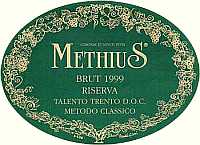
|
|
Trento Talento Brut Riserva Methius 1999 |
|
| Dorigati (Italy) | |
| Grapes: Chardonnay (60%), Pinot Noir (40%) | |
| Price: € 32.00 | Score: |
| A great classic method sparkling wine. This Talento shows an intense straw yellow color and nuances of straw yellow, very transparent, good effervescence, fine and very persistent perlage. The nose reveals good personality with intense, clean, pleasing, refined and elegant aromas which start with hints of banana and bread crust followed by aromas of acacia, pineapple, butter, hawthorn, kiwi, yeast, apple, honey, grapefruit, hazelnut, plum, chamomile and hints of vanilla. The mouth has excellent correspondence to the nose, a crisp and effervescent attack, pleasing smoothness, however well balanced by alcohol, good body, intense flavors, agreeable. The finish is very persistent with long flavors of banana, honey, grapefruit, apple and hazelnut. A great Talento. Part of the Chardonnay used for the preparation of base wine ferments in barrique. Methius ages in bottle on its lees for about five years and after disgorgement ages in bottle for 6-8 months. | |
| Food Match: Roasted fish, Broiled crustaceans, Pasta and risotto with fish, Roasted white meat | |
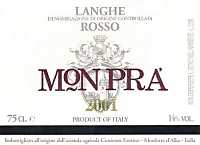
|
|
Langhe Rosso Monprà 2001 |
|
| Conterno Fantino (Italy) | |
| Grapes: Nebbiolo, Barbera, Cabernet Sauvignon | |
| Price: € 27.50 | Score: |
| The wine shows an intense ruby red color and nuances of garnet red, little transparency. The nose reveals intense, clean, pleasing, refined and elegant aromas that start with hints of black currant, black cherry and plum followed by aromas of blueberry, strawberry jam, violet, vanilla, licorice, cocoa, tobacco and eucalyptus. The mouth has good correspondence to the nose, a tannic attack and however balanced by alcohol, full body, intense flavors, good tannins, agreeable. The finish is persistent with flavors of black cherry, plum and black currant. A well made wine. Langhe Rosso Monprà ages for 18 months in barrique followed by 6 months of aging in bottle. | |
| Food Match: Stewed and braised meat, Roasted meat, Broiled meat and barbecue, Hard cheese | |
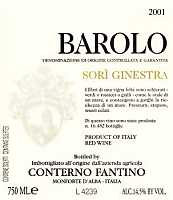
|
|
Barolo Sorì Ginestra 2001 |
|
| Conterno Fantino (Italy) | |
| Grapes: Nebbiolo | |
| Price: € 57.50 | Score: |
| This Barolo shows a brilliant ruby red color and nuances of garnet red, little transparency. The nose reveals intense, clean, pleasing, refined and elegant aromas which start with hints of cherry, plum and violet followed by aromas of dried rose, vanilla, licorice, tobacco, cocoa, mace, menthol and thyme. The mouth has good correspondence to the nose, a tannic attack and however balanced by alcohol, full body, intense flavors, good tannins. The finish is very persistent with long flavors of cherry and plum. A well made wine. Barolo Sorì Ginestra ages for 24 months in barrique followed by 12 months of aging in bottle. | |
| Food Match: Game, Braised and stewed meat with mushrooms, Roasted meat, Hard cheese | |
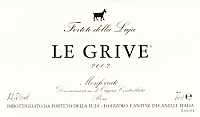
|
|
Monferrato Rosso Le Grive 2002 |
|
| Forteto della Luja (Italy) | |
| Grapes: Barbera (80%), Pinot Noir (15%), Cabernet Sauvignon (5%) | |
| Price: € 15.00 | Score: |
| The wine shows an intense ruby red color and nuances of garnet red, little transparency. The nose reveals intense, clean, pleasing and refined aromas which start with hints of cherry, plum and violet followed by aromas of vanilla, licorice, cocoa, cinnamon, tobacco and menthol. The mouth has good correspondence to the nose, a tannic attack and pleasing crispness, however well balanced by alcohol, full body, intense flavors, good tannins. The finish is persistent with flavors of cherry and plum. A well made wine. Monferrato Le Grive ages in cask for 6 months. | |
| Food Match: Roasted meat, Braised and stewed meat, Hard cheese | |

|
|
Moscato d'Asti Piasa San Maurizio 2004 |
|
| Forteto della Luja (Italy) | |
| Grapes: Muscat Blanc | |
| Price: € 9.00 | Score: |
| The wine shows a brilliant greenish yellow color and nuances of greenish yellow, very transparent, good effervescence, fine and persistent perlage. The nose reveals good personality with intense, clean, pleasing and refined aromas which start with hints of grape and peach followed by aromas of acacia, citrus fruits, apple, litchi, citronella, sage, pear and honey. The mouth has good correspondence to the nose, a sweet, crisp and effervescent attack, however balanced, light body, intense flavors, agreeable. The finish is persistent with flavors of grape, peach, pear and litchi. A well made wine. | |
| Food Match: Cream desserts, Fruit desserts, Semifreddo, Panettone | |

|
|
Valtellina Rosso 2003 |
|
| Le Strie (Italy) | |
| Grapes: Chiavennasca (Nebbiolo) (95%), Rossola, Pignola, Brugnola (5%) | |
| Price: € 11.50 | Score: |
| The wine shows a pale ruby red color and nuances of garnet red, moderate transparency. The nose denotes intense, clean, pleasing and refined aromas which start with hints of cherry, plum and violet followed by aromas of raspberry, cyclamen, blueberry, licorice and vanilla. The mouth has good correspondence to the nose, a slightly tannic attack and pleasing crispness, however balanced by alcohol, good body, intense flavors, good tannins. The finish is persistent with flavors of cherry and plum. This Valtellina is made with the “rinforzo” technique, that is by adding wine from dried grapes, and ages for 9 months in cask. | |
| Food Match: Broiled meat and barbecue, Stewed meat with mushrooms, Stuffed pasta | |

|
|
Friuli Isonzo Sauvignon 2004 |
|
| Luisa (Italy) | |
| Grapes: Sauvignon Blanc | |
| Price: € 13.50 | Score: |
| This Sauvignon Blanc shows a pale straw yellow color and nuances of greenish yellow, very transparent. The nose reveals intense, clean, pleasing and refined aromas that start with hints of peach, pineapple and elder followed by aromas of litchi, pear, gooseberry, nettle and bell pepper. The mouth has good correspondence to the nose, a crisp attack and however balanced by alcohol, good body, intense flavors, agreeable. The finish is persistent with flavors of peach, pineapple and litchi. This wine ages for 7 months in steel tanks followed by 2 months of aging in bottle. | |
| Food Match: Fish and crustaceans appetizers, Fried fish, Pasta and risotto with fish and vegetables | |
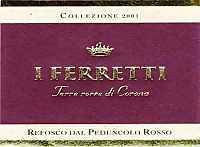
|
|
Friuli Isonzo Refosco dal Peduncolo Rosso I Ferretti 2001 |
|
| Luisa (Italy) | |
| Grapes: Refosco dal Peduncolo Rosso | |
| Price: € 20.00 | Score: |
| The wine shows an intense ruby red color and nuances of ruby red, little transparency. The nose reveals intense, clean, pleasing and refined aromas which start with hints of black cherry and plum followed by aromas of blackberry, raspberry, blueberry, bell pepper, menthol, violet, vanilla and carob. The mouth has good correspondence to the nose, a slightly tannic attack and however balanced by alcohol, good body, intense flavors, good tannins. The finish is persistent with flavors of black cherry, plum and raspberry. This Refosco dal Peduncolo Rosso ages for more than 15 months in cask followed by 12 months of aging in bottle. | |
| Food Match: Roasted meat, Braised and stewed meat, Hard cheese | |
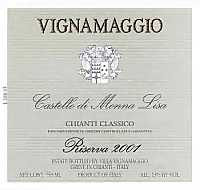
|
|
Chianti Classico Riserva Castello di Monna Lisa 2001 |
|
| Vignamaggio (Italy) | |
| Grapes: Sangiovese (90%), Cabernet Sauvignon (10%) | |
| Price: € 21,50 | Score: |
| This Chianti Reserve shows an intense ruby red color and nuances of garnet red, little transparency. The nose reveals intense, clean, pleasing and refined aromas which start with hints of black cherry, plum and violet followed by aromas of blueberry, vanilla, tobacco, cinnamon, licorice, mace and menthol. The mouth has good correspondence to the nose, a tannic attack and however balanced by alcohol, full body, intense flavors, good tannins. The finish is persistent with flavors of black cherry and plum. This Chianti ages in cask for 18-20 months followed by at least 6 months of aging in bottle. | |
| Food Match: Roasted meat, Braised and stewed meat, Hard cheese | |
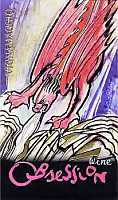
|
|
Wine Obsession 2001 |
|
| Vignamaggio (Italy) | |
| Grapes: Merlot, Cabernet Sauvignon, Syrah | |
| Price: € 31.25 | Score: |
| This wine shows an intense ruby red color and nuances of garnet red, little transparency. The nose reveals intense, clean, pleasing, refined and elegant aromas that start with hints of black cherry, plum and black currant followed by aromas of blueberry, bell pepper, violet, vanilla, tobacco, licorice, cocoa, mace, eucalyptus and hints of wet earth. The mouth has good correspondence to the nose, a tannic attack and however balanced by alcohol, full body, intense flavors, good tannins, agreeable. The finish is persistent with flavors of black cherry, plum and black currant. A well made wine. Wine Obsession ages for 18-20 months in barrique followed by at least 6 months of aging in bottle. | |
| Food Match: Game, Stewed and braised meat, Roasted meat, Hard cheese | |
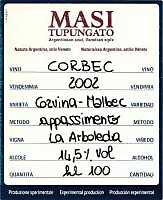
|
|
Corbec 2002 |
|
| Masi - Tupungato (Argentina) | |
| Grapes: Corvina (70%), Malbec (30%) | |
| Price: € 19.90 | Score: |
| This wine shows an intense ruby red color and nuances of garnet red, little transparency. The nose reveals intense, clean, pleasing, refined and elegant aromas which start with hints of blackberry, plum and black cherry followed by aromas of dried violet, licorice, vanilla, tobacco, cinnamon, anise, chocolate and menthol. The mouth has good correspondence to the nose, a tannic attack and however balanced by alcohol, full body, intense flavors, good tannins. The finish is persistent with flavors of blackberry, black cherry and plum. A well made wine. Corbec is made with slightly dried grapes and ages for 18 months in barrique. | |
| Food Match: Game, Roasted meat, Braised and stewed meat, Hard cheese | |

|
|
Amarone della Valpolicella Classico Costasera 2001 |
|
| Masi (Italy) | |
| Grapes: Corvina (70%), Rondinella (25%), Molinara (5%) | |
| Price: € 25.90 | Score: |
| This Amarone shows a brilliant ruby red color and nuances of garnet red, little transparency. The nose denotes intense, clean, pleasing, refined and elegant aromas which start with hints of black cherry, plum and blackberry followed by aromas of blueberry, violet, vanilla, licorice, tobacco, cocoa, cinnamon, black pepper and eucalyptus. The mouth has good correspondence to the nose, a tannic attack and however balanced by alcohol, full body, intense flavors, good tannins, agreeable. The finish is persistent with flavors of blackberry, black cherry and plum. A well made wine. Amarone Costasera ages for 24 months in cask followed by at least 4 months of aging in bottle. | |
| Food Match: Game, Roasted meat, Braised and stewed meat, Hard cheese | |
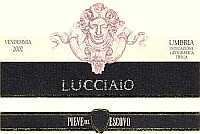
|
|
Lucciaio 2002 |
|
| Pieve del Vescovo (Italy) | |
| Grapes: Merlot (45%), Cabernet Sauvignon (40%), Sangiovese (15%) | |
| Price: € 20.00 | Score: |
| The wine shows an intense ruby red color and nuances of garnet red, little transparency. The nose denotes intense, clean, pleasing and refined aromas which start with hints of black cherry, plum and violet followed by aromas of blueberry, black currant, vanilla, licorice, menthol and carob. The mouth has good correspondence to the nose, a tannic attack and however balanced by alcohol, full body, intense flavors, good tannins. The finish is persistent with flavors of black cherry, plum and black currant. A well made wine. Lucciaio ages for 10 months in barrique followed by 4 months of aging in bottle. | |
| Food Match: Braised and stewed meat, Roasted meat, Hard cheese | |

|
|
Tezio 2002 |
|
| Pieve del Vescovo (Italy) | |
| Grapes: Merlot (50%), Cabernet Sauvignon (50%) | |
| Price: € 30.00 | Score: |
| This wine shows a deep ruby red color and nuances of garnet red, little transparency. The nose reveals intense, clean, pleasing, refined and elegant aromas which start with hints of black cherry, black currant and plum followed by aromas of blueberry, violet, blackberry, bell pepper, tobacco, vanilla, licorice, cocoa and eucalyptus. The mouth has good correspondence to the nose, a tannic attack and however balanced by alcohol, full body, intense flavors, good tannins. The finish is persistent with flavors of black cherry, plum and black currant. A well made wine. Tezio ages for 13 months in barrique followed by 7 months of aging in bottle. | |
| Food Match: Game, Stewed and braised meat, Roasted meat, Hard cheese | |
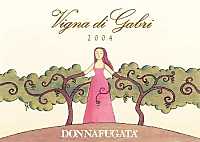
|
|
Contessa Entellina Vigna di Gabri 2004 |
|
| Donnafugata (Italy) | |
| Grapes: Inzolia | |
| Price: € 9.80 | Score: |
| This wine shows a brilliant golden yellow color and nuances of golden yellow, very transparent. The nose denotes intense, clean, pleasing and refined aromas which start with hints of pear, apple and plum followed by aromas of banana, hawthorn, vanilla and hints of coffee. The mouth has good correspondence to the nose, a crisp attack and pleasing roundness, however balanced by alcohol, good body, intense flavors. The finish is persistent with flavors of plum, apple and banana. Part of the must used for the production of Vigna di Gabri ferments in barrique. The wine ages for at least 4 months in bottle. | |
| Food Match: Stuffed pasta, Pasta with mushrooms, Broiled fish, Roasted fish, Sauteed white meat | |
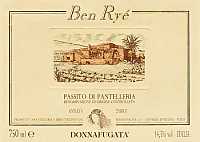
|
|
Moscato di Pantelleria Ben Ryé 2003 |
|
| Donnafugata (Italy) | |
| Grapes: Zibibbo (Muscat of Alexandria) | |
| Price: € 35.20 | Score: |
| This Moscato di Pantelleria shows an intense amber yellow color and nuances of amber yellow, transparent. The nose reveals intense, clean, pleasing, refined and elegant aromas which start with hints of raisin, dried fig and candied fruit followed by aromas of apricot jam, peach jam, date, almond, litchi, lavender, citrus fruit peel and honey. The mouth has good correspondence to the nose, a sweet and round attack, however balanced by alcohol, good body, intense flavors, agreeable. The finish is persistent with flavors of raisin, dried fig, date and honey. A well made wine. Ben Ryé ages for at least 4 months in bottle. | |
| Food Match: Dried fruit and almond tarts, Hard and piquant cheese | |
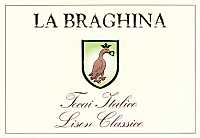
|
|
Lison Pramaggiore Tocai Italico Lison Classico 2004 |
|
| La Braghina (Italy) | |
| Grapes: Tocai Friulano | |
| Price: € 8.00 | Score: |
| The wine shows an intense greenish yellow color and nuances of greenish yellow, very transparent. The nose denotes clean and pleasing aromas that start with hints of pear, apple and hawthorn followed by aromas of almond, broom and plum. The mouth has good correspondence to the nose, a crisp attack and however balanced by alcohol, good body, intense flavors. The finish is pretty persistent with flavors of pear, apple and almond. This wine ages for 4 months in steel tanks. | |
| Food Match: Fried fish, Risotto with vegetables, Dairy products | |
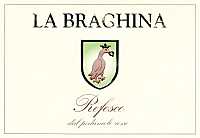
|
|
Lison Pramaggiore Refosco dal Peduncolo Rosso 2004 |
|
| La Braghina (Italy) | |
| Grapes: Refosco dal Peduncolo Rosso | |
| Price: € 9.50 | Score: |
| This wine shows a brilliant ruby red color and nuances of ruby red, moderate transparency. The nose denotes clean and pleasing aromas that start with hints of black cherry, plum and blueberry followed by aromas of raspberry, cyclamen and violet. The mouth has good correspondence to the nose, a slightly tannic attack and however balanced by alcohol, good body, intense flavors. The finish is pretty persistent with flavors of black cherry and plum. This wine ages in steel tanks for 5 months. | |
| Food Match: Sauteed meat with mushrooms, Stuffed pasta, Roasted white meat | |
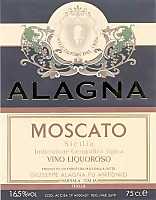
|
|
Moscato Sicilia |
|
| Alagna (Italy) | |
| Grapes: Zibibbo (Muscat of Alexandria) | |
| Price: € 5.00 | Score: |
| This wine shows a brilliant amber yellow color and nuances of amber yellow, transparent. The nose reveals intense, clean, pleasing and refined aromas which start with hints of raisin, citrus fruit peel and dried fig followed by aromas of candied fruit, honey, date, almond and apricot jam. The mouth has good correspondence to the nose, a sweet and round attack, however balanced by alcohol, good body, intense flavors. The finish is persistent with flavors of raisin, dried fig and candied fruit. | |
| Food Match: Dried fruit tarts, Baked desserts, Hard cheese | |

|
|
Marsala Vergine Baglio Baiata |
|
| Alagna (Italy) | |
| Grapes: Grillo, Catarratto | |
| Price: € 10.00 | Score: |
| This Marsala shows a brilliant amber yellow color and nuances of amber yellow, transparent. The nose reveals intense, clean, pleasing and refined aromas which start with hints of dried fig and rancho followed by aromas of almond, licorice, leather, date, honey, vanilla and citrus fruit peel. The mouth has good correspondence to the nose, an alcoholic attack, pleasing crispness and roundness, however balanced, full body, intense flavors. The finish is persistent with flavors of dried fig, almond and date. This Marsala Vergine ages for at least 5 years in cask and then is processed with the “perpetuo” system. | |
| Food Match: Aperitifs, Hard and piquant cheese | |
AdantiAmong the placid and picturesque hills of green Umbria, in Arquata place, Adanti winery is since more than thirty years among the main protagonists of the renowned Sagrantino di Montefalco |
|
The view of Umbria - the green heart of Italy - with its uninterrupted scenario of hills, offers among the most evocative and placid territories of Italy. Since ever these hills - as far as the memory and the history of man can recall - have always been characterized by vineyards and olive trees, two fundamental elements of the enogastronomical culture and tradition of Umbria. Besides being remembered as a “land of saints and heroes”, Umbria is also a land of olive oil and wine, as it was usually mentioned by authors of the past since ancient Roman times. Also famous were the grapes cultivated in Umbria and with which were produced wine: among the many, Pliny the Elder praised the Itriola grape, typical of the ancient Mevania - name with which the ancient Romans called the modern city of Bevagna, between Foligno and Montefalco - therefore proving at those times the wine of these places was famous for its quality.
Right in the hills near Bevagna, an enchanting town of long medieval traditions and included in the production area of Sagrantino di Montefalco DOCG, is located Adanti winery, which in its more than thirty years of history has been capable of representing a solid reference point in the production and development of this famous Umbrian wine. The headquarter of the winery is located in the hill of Arquata, Colcimino and Torre del Colle, famous since ancient times for the quality and finesse of their wines and olive oils. The history of this important Umbrian winery - still today considered a reference point for the production of Sagrantino di Montefalco - began in 1974, when Domenico and Pietro Adanti brothers founded their wine business. The headquarter of the winery was built by recovering and restoring an ancient convent belonged to the congregation of Filippini monks, built on the rests dated back to Roman times and to the late Renaissance. Those were times in which Sagrantino grape was vinified according to the traditions of this area, by allowing the grapes to dry on mats - a very common practice used in the whole territory of Umbria - which was then vinified in order to obtain a tannic and sweet wine, traditionally consumed in the Easter period and during holidays. That was also the period in which sweet wines did not meet the favor of consumers and Sagrantino - because of its traditional vinification - was probably destined to disappear while leaving its place in vineyards to other and more famous grapes. Some producers of the area began to produce dry versions of wines by using Sagrantino grape, however the result was pretty tannic and astringent, with organoleptic qualities that, with time, got flavors of almonds. It should be remembered Sagrantino grape has a content in polyphenols among the highest known in any grapes, even higher than Nebbiolo.
Among these producers was also the winery of Adanti brothers that, later, will introduce new ways to think about dry Sagrantino and about its production. Around the end of 1970's, Domenico Adanti hired as a cellar master Mr. Alvaro Palini - who after having spent a long time in the fashion field and after having worked in Italy and in France - gets into the world of wine while revolutionizing the way of thinking and producing Sagrantino. Alvaro Palini - a coy, tenacious and determined man with clear ideas - understands the secret of Sagrantino grape consisted in radically changing the way that “rough” wine was produced and the change needed to begin in the vineyard. He decided to lower yields in vineyards, he changed the vinification and aging techniques in order to obtain a better balance in the fruity character of the grape, tannins and acid. He also decided to have the wine slowly aging in oak casks and to continue the aging in bottle: changes which will make the future of the production of dry Sagrantino and of its success. The changes introduced by Alvaro Palini allowed Adanti winery to reach remarkable successes in a short time, therefore becoming the reference model for dry Sagrantino, as well as for the traditional Passito style. The first great success arrived with vintage 1985, a wine that still today is capable of surprising for its qualities and for its evolution. A success confirmed five years later with vintage 1990. Thanks to the intuition and skill of Alvaro Palini, it was also produced one of the most renowned and famous wines of Adanti winery: Arquata Rosso. This elegant wine is created by Cabernet Sauvignon and Merlot to which is added Barbera: a very well made wine that since the first year of its production - it was 1981 - has always represented the quality of Adanti winery and that should certainly be considered - even in the current vintage 2000 - among the best red wines of Umbria. Today the technical management of the wine production has passed to Ms. Graziana Grassini, the clever and talented wine maker from Grosseto. Graziana Grassini scrupulously continues with her talent to keep the quality of this historical Umbrian winery high. The result of her skill and of her talent is proven in the glass: in every Adanti's wine emerges intact the typical quality of the grapes and the organoleptic sensations typical of wood aging are never intrusive or inappropriate, while giving the wines a very good olfactory and gustatory balance. The production of Adanti winery includes both white and red wines. Among white wines there are Montefalco Bianco (Grechetto, Chardonnay and Trebbiano Toscano) and the very good Colli Martani Grechetto. The range of red wines begins with Montefalco Rosso (Sangiovese, Sagrantino, Barbera, Merlot and Cabernet Sauvignon), followed by Sagrantino di Montefalco and the excellent Arquata Rosso (Cabernet Sauvignon, Cabernet Franc, Merlot and Barbera). The production also includes the typical sweet wines of the area and of Umbria such as Sagrantino di Montefalco Passito and Vinsanto dell'Umbria (Grechetto, Malvasia, Trebbiano Toscano and Garganega). Finally, with the pomace of Sagrantino is being produced a grappa distilled with a discontinuous steam operated alembic still by Distilleria Aquileia.
|
||||||||||||||||||||
|
Score legend Prices are to be considered as indicative. Prices may vary according to the country or the shop where wines are bought |
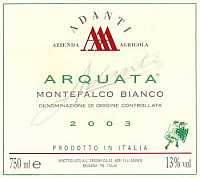
|
|
Montefalco Bianco 2003 |
|
| Adanti (Italy) | |
| Grapes: Grechetto (50%), Chardonnay (30%), Trebbiano Toscano (20%) | |
| Price: € 7.50 | Score: |
| This wine shows an intense golden yellow color and nuances of golden yellow, very transparent. The nose reveals intense, clean and pleasing aromas which start with hints of quince and plum followed by aromas of hawthorn, pear, hazelnut, pineapple and ripe peach. The mouth has good correspondence to the nose, a crisp attack and however balanced by alcohol, good body, intense flavors, agreeable. The finish is persistent with flavors of pear, plum and pineapple. This Montefalco Bianco ages in steel tanks for 4 months. | |
| Food Match: Fried fish, Roasted white meat, Roasted fish, Stuffed pasta | |
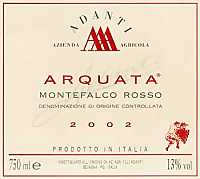
|
|
Montefalco Rosso 2002 |
|
| Adanti (Italy) | |
| Grapes: Sangiovese (65%), Sagrantino (15%), Barbera (10%), Merlot (5%), Cabernet Sauvignon (5%) | |
| Price: € 11.00 | Score: |
| The wine shows a brilliant ruby red color and nuances of garnet red, moderate transparency. The nose denotes intense, clean and pleasing aromas which start with hints of black cherry, violet and plum followed by aromas of blueberry, vanilla, licorice and hints of menthol. The mouth has good correspondence to the nose, a slightly tannic attack and pleasing smoothness, however balanced by alcohol, good body, intense flavors, good tannins. The finish is persistent with flavors of black cherry, plum and blueberry. This Montefalco Rosso ages for 12 months in cask. | |
| Food Match: Sauteed meat with mushrooms, Broiled meat and barbecue, Stewed meat | |
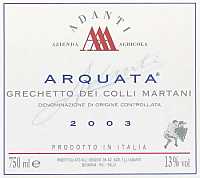
|
|
Colli Martani Grechetto 2003 |
|
| Adanti (Italy) | |
| Grapes: Grechetto | |
| Price: € 8.50 | Score: |
| The wine shows a brilliant golden yellow color and nuances of golden yellow, very transparent. The nose reveals intense, clean, pleasing and refined aromas which start with hints of apple and plum followed by aromas of hawthorn, broom, pear, hazelnut and lemon. The mouth has good correspondence to the nose, a crisp attack and however balanced by alcohol, good body, intense flavors. The finish is persistent with flavors of apple, plum and pear. This Grechetto ages in steel tanks for 4 months. | |
| Food Match: Fish and mushrooms soups, Stuffed pasta, Sauteed white meat, Broiled fish | |

|
|
Sagrantino di Montefalco 2000 |
|
| Adanti (Italy) | |
| Grapes: Sagrantino | |
| Price: € 21.00 | Score: |
| This Sagrantino shows an intense ruby red color and nuances of garnet red, little transparency. The nose denotes intense, clean, pleasing and refined aromas which start with hints of blackberry, black cherry and plum followed by aromas of blueberry, raspberry, violet, vanilla, licorice, tobacco and chocolate. The mouth has good correspondence to the nose, a tannic attack and however balanced by alcohol, full body, intense flavors, good tannins, agreeable. The finish is persistent with flavors of blackberry, black cherry and plum. A well made wine. This Sagrantino di Montefalco ages in cask for 20 months followed by about 12 months of aging in bottle. | |
| Food Match: Game, Braised and stewed meat, Roasted meat, Hard cheese | |

|
|
Sagrantino di Montefalco Passito 2001 |
|
| Adanti (Italy) | |
| Grapes: Sagrantino | |
| Price: € 28.50 - 500ml | Score: |
| The wine shows a deep ruby red color and nuances of ruby red, impenetrable to light. The nose reveals intense, clean, pleasing, refined and elegant aromas which start with hints of blackberry, plum and black cherry followed by aromas of blueberry, dried violet, vanilla, licorice, tobacco, start anise, cinnamon, clove and chocolate. The mouth has good correspondence to the nose, a tannic and sweet attack with pleasing roundness, however well balanced by alcohol, full body, intense flavors, good tannins, agreeable. The finish is persistent with flavors of blackberry, black cherry, plum and blueberry. A well made wine. This Sagrantino Passito ages in cask for 30 months. | |
| Food Match: Hard cheese, Chocolate tarts, Fruit tarts | |
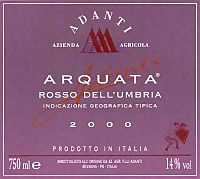
|
|
Arquata Rosso 2000 |
|
| Adanti (Italy) | |
| Grapes: Cabernet Sauvignon, Cabernet Franc (40%), Merlot (40%), Barbera (20%) | |
| Price: € 18.00 | Score: |
| This wine shows an intense ruby red color and nuances of garnet red, little transparency. The nose reveals intense, clean, pleasing, refined and elegant aromas which start with hints of plum, black currant and black cherry followed by aromas of blueberry, blackberry, violet, vanilla, licorice, tobacco, cinnamon, menthol and cocoa. The mouth has good correspondence to the nose, a tannic attack and however balanced by alcohol, full body, intense flavors, good tannins. The finish is persistent with flavors of black currant, plum and black cherry. A well made wine. Arquata Rosso ages in cask for about 20 months followed by 6 months of aging in bottle. | |
| Food Match: Game, Braised and stewed meat, Roasted meat, Hard cheese | |
| Adanti - 06031 Arquata di Bevagna, Perugia (Italy) - Tel. +39 742 360295 Fax. +39 742 361270 - Winemaker: Graziana Grassini - Established: 1974 - Production: 120.000 bottles - E-Mail: info@cantineadanti.com - WEB: www.cantineadanti.com |
Cellar Journal |
|
This section is reserved to wine producers who want to publish news and information about their business, to announce new products or just for communicating to its customers information and promotions about their products and activity. Send news to be published at our e-mail address.
|
News |
|
In this section will be published news and information about events concerning the world of wine and food. Whoever is interested in publishing this kind of information can send us a mail at our address.
|
Distillates' FaultsA quality distillate is, first of all, a faultless distillate, without negative organoleptic elements that can compromise the perception of its positive characteristics |
|
The exercise of organoleptic and sensorial tasting of distillates - just like in wine - requires practice, commitment, concentration and the capacity of remembering sensorial stimuli in order to recognize them and to use this experience in subsequent occasions. The goals of the tasting of a product can be many: it can be tasted for the pleasing sensations it can give, it can be tasted in order to define its quality and elegance, or it can be tasted in order to determine, in a hypothetical rank, what is the best product, just to mention some cases. Despite the reason why a product is being tasted - in our case a distillate - an essential factor determining its appreciation is represented by quality, a characteristic that, first of all, is expressed in the absence - or in the least possible number - of faults that could compromise the perception and the appreciation of all the positive characteristics. The capacity of recognizing faults in distillates is essential as these negative qualities make mediocre and not very pleasing a product, a characteristic which is frequently found in many brandies. The art of distillation is a process whose result is determined by many factors, including the quality of raw matter and of its keeping, the distillation system, the skill and knowledge of the distiller, as well as the practices used for giving a distillate its typicality before bottling. Each one of these phases has critical phases which frequently compromise the whole quality of a distillate even though - for many faults developed during the processing - a new distillation can fix the problem or however make it less evident. Faults which are frequently found in low or mediocre quality distillates and therefore it is essential to be able to recognize them.
A fundamental premise should be done about the glass used for the evaluation of a distillate. One of the most frequent faults found in distillates is alcohol pungency which tends to cover all the other aromatic qualities. As opposed to other aromatic substances, alcohol is a highly volatile element and it does not certainly need any particular encouragement - by means of the shape of the glass - in order to express its ethereal and pungent aroma. As the excessive alcohol pungency is considered a fault, it should be remembered this characteristic is strongly influenced by the shape and the volume of a glass. In a glass having a large shape - such as the well known short stemmed balloon glass, frequently used for the service of distillates aged in wood - this quality is excessively exalted, whereas in a tulip glass - narrower and less wide - the same quality will be strongly attenuated. As an example it can be compared the aromatic impact of alcohol in a balloon glass and in a tulip glass: the difference will be evident and will immediately make this concept clear. Another fundamental characteristic for the right appreciation of distillates is temperature. If it is true a wrong glass can excessively exalt alcohol pungency, the same is true for high temperatures. At low temperatures alcohol pungency will be attenuated and more tolerable, however will also be attenuated all the other organoleptic qualities, including any possible fault. Ideal serving temperatures for distillates vary according to the type. For brandies non aged in wood, such as young grappa and fruit brandies, the temperature should be from 8°C to 12°C (46°F-54°F); distillates aged for a short time in wood casks, from 14 to 16°C (57°-61°F); whereas for brandies aged for a long time in wood casks the serving temperature should be of 18°C (65°F). Higher temperatures will excessively exalt the ethereal and pungent quality of alcohol, whereas temperatures lower than 6°C (43°F) will make distillates taste oily and fatty as well as attenuating - almost completely - the olfactory perception of aromas. Another practice to avoid is to warm the glass and the distillate by using a flame: in this way the pungency and ethereal quality of alcohol will be exalted, they will develop burnt faults and the distillate will lose its finesse.
|
||||||||
|
Every fresh distilled brandy - when it comes out from the alembic's cooler - is very limpid, crystalline and has no fault in the appearance, provided the distiller did a good job, of course. From this moment on, the appearance of distillate can only get worse because of mistakes made during the procedures required to obtain a brandy according to its typicality. Among the faults which can be found in a distillate, the ones concerning the appearance are to be considered very rare, also thanks to the many technologies which can eventually help to fix some mistakes. Producing a limpid and crystalline distillate - although this is an essential characteristic - does not require a particular skill, saved the correct use and the knowledge of practices which avoid the production of brandies with appearance faults. For this reason, a distillate showing faults in its aspect is to be considered of bad quality, as well as signaling the scarce capacity of the distiller in his or her job. A serious fault is a milky appearance which could compromise - even minimally - transparency. Distillates, as they are produced from the alembic, have pretty high alcoholic volumes - even up to 86% - therefore, in order to make them suitable for consumption, the alcohol volume is properly lowered. This operation - done by adding distilled water - makes the distillate turbid or milky and it will be necessary to eliminate this fault by means of a proper cooling followed by filtering. This operation gives the distillate its original transparency. As for color, young distillates non aged in wood will always be colorless and transparent like water: any yellow nuance or hue is to be considered a fault. Color in distillates aged in wood containers is so variable which is pretty hard - and disputable - talking about faults, as this quality could correspond to what the producer wanted. It is good to remember caramel can be used in order to deep the intensity of color in distillates and it is allowed in many cases, however a brandy aged for few months or few years in a cask and showing a pretty deep color could signal the use of an excessive quantity of caramel. Not really a fault, but certainly a disputable choice in order to make a distillate look older than what it really is.
|
||||
|
If it is true it is hard to find a distillates having faults in the appearance, the same cannot be said for olfactory qualities. In fact it is in the aromas which faults are more frequently found in distillates, and it is thanks to the olfactory characteristics of a distillate which can be largely understood both the quality of the raw matter as well as the skill of the distiller. The art of distillation can be seen as a simple process: after all it is enough to heat a fermented raw matter and to wait for the distillate to come out from the alembic. Despite the simplicity with which the process of distillation can be summarized, indeed this is an extremely and delicate process in which all the knowledge and the skill of a talented distiller are required in order to obtain a high quality product, first of all, faultless. It is right from the capacity of producing a faultless distillate which makes distillation both a noble art and a complex process, in which by just neglecting one single detail means compromising the final result. An effect which is, first of all, detrimental for the most pleasing aspect of a distillate - the aromas - and, last but not the least, its taste. One of the most frequent faults in distillates is the excessive alcohol pungency, a characteristic that, besides covering other aromas, can also cause painful reactions during the olfactory evaluation. Concerning this aspect, it is appropriate to remember the quantity of ethyl alcohol in distillates can also represent about the half of the volume, therefore alcohol pungency will always be present, although with different intensities. Moreover, it must be remembered the pungency fault - besides being caused by alcohol - is also accentuated by other volatile substances. For this reason, the fault of pungency, unfortunately found in many distillates, it is the sign of a bad distillation as well as of a bad keeping of the raw matter. Among the main olfactory faults are mentioned:
|
|
Faults in distillates are frequently found in their tastes as well and - just like for olfactory faults - they compromise the quality and agreeability of a brandy. Just like aromas, even in the taste the pungency of alcohol can compromise the quality of a distillate and, when excessive, it is considered a fault. Distillates contain high quantities of alcohol and therefore the burning effect which develops in the mouth after its introduction is normal. However the development of this tactile quality it is not the same in all distillates - also accentuated by other components - and in a good distillate the burning pungency of alcohol should be perceived in the beginning and then dissolve rapidly while allowing the other flavors to develop. Even in this case, the absence of gustatory faults is the sign of the skill and mastery of the distiller during the processing of the raw matter. Following is a list of the most frequent gustatory faults found in distillates.
|
CinnamonA small tree growing in the forests of Ceylon island, in the Western Indies, has strongly influenced the trades from East to Europe as well as being a strategic good for naval trades of the past |
|
A tree providing great help to humans, both as a spice to flavoring and aromatizing daily foods, as well as a remedy. Cinnamon, whose scientific name is Cinnamomum Zeylanicum, is a small evergreen tree growing wild in forests, it does not have a specific geographical origin, it is however certain it comes from Ceylon or southern India. Today its cultivation has spread in the Seychelles, Java, Sumatra, Brazil and Jamaica. The scientific name derives from the Arab words “kin” and “anomon”, meaning “aromatic plant from China”. The reason of these terms refers to another cinnamon, the one coming from China, whereas the cinnamon from Ceylon, the one we are talking about, arrived in Europe in the sixteenth century. The name “cinnamon” derives from the Arab kin-anomon, and the names used in past times in Europe also derived from this term, for example, in Italy cinnamon was once called cinnamomo. With the term “cinnamon” is referred the spice prepared with the bark of two vegetal species and both belonging to the Cinnamomum family: Cinnamomum Zeylanicum and Cinnamomum Cassia. The Cinnamomum Zeylanicum is an evergreen tree whose bark - very thin and fragile - is being dried therefore getting the characteristic rolled aspect. The texture is smooth and the color is brown, getting darker inside. This spice is also known as queen cinnamon, maybe for emphasizing its superior quality and aroma. Cinnamomum Cassia, or Chinese cinnamon, is a tree from China, and its dried bark has a wrinkled aspect, a thickness of more than one millimeter and the color tends to gray. It also has a weaker aroma and an inferior quality than Ceylon's cinnamon.
Cinnamon was used by human beings since ancient times: it seems Chinese used it since 2,700 BC, whereas Egyptians used cinnamon during the embalming processes since 2,000 BC. Romans considered cinnamon sacred, and the emperor Nero burnt it during the funeral of his mother. In the Middle Age the most noble classes used cinnamon as a sign of richness and power. During banquets were served cinnamon and other spices, probably for impressing guests. The custom of donating spices to princes and queens, makes us understand the importance they had at those times. It was not by chance - and as it has been proven - cinnamon and black pepper were the main goods traded by the economies of the past. After the journey of Vasco de Gama in 1505 and the following occupation of Ceylon, the trade of cinnamon received a significative impulse, up to reaching a level which was capable of influencing the trades and the interests of naval powers of those times. The high profits ensured by spices, make us understand the reason why so many great seafaring of the past decided to start risky and hard journeys - facing serious dangers for themselves and the life of the crew - with no instruments, transported by winds, crossing unknown seas. Remarkable enterprises which certainly are hard for twenty century's modern crews as well. Many seafaring of the past sailed the seas in search for spices and high profits: Bartolomeo Diaz (1487), the Portuguese who discovered the most southern language in Africa, and that by circumnavigating it reached Indies; Vasco de Gama (1497), that after a very risky journey, he was successful in reaching Indies thanks to the advices of Arab merchants; Christopher Columbus (1492) who tried to find a new way for the Indies; Pedro Alvares Cabral (1500) who sailed towards Indies (and accidentally discovered Brazil) with thirteen ships and came back with only six but full of black pepper. The people of the Middle Age made a wide use of spices. The reason of this strong use can be explained by the life styles of those times. The variety and abundance of vegetables was not as high as we have it today, during wintertime the scarcity of forage and vegetables forced people to butcher animals and to preserve it with salt in order to be consumed in the cold season. Meals were therefore pretty repetitive: meat kept in salt and some vegetables. In order to make food more tasty - as well as to cover any bad smell or flavor - they used spices. Whoever traveled in India or Africa, in those areas where the variety of food is scarce (rice and lentils, rice and chickpeas, for example) will have noticed the huge quantity of spices used to diversify, renew and make more pleasing the miserable meals, otherwise insipid and repetitive. The condition during the Middle Age was not that different. For this reason foods were enriched with spices and very tasty or hot sauces. Only spices could give countless flavors and aromas to the same meals. The use of spices was not exclusively reserved to rich and noble people, their use was also common among other people: this explains the wide consumption and the huge demand of such goods. The first great merchants of history were Arabs, who transported goods from India and China to the Mediterranean and then were sold to Europeans. The greatest spice merchants were Venetians. Around the half of fifteenth century Turks began to intercept and depredate the caravans coming from the East, for this reason spices began to become rare in Europe. In the sixteenth century Portuguese found a new way - by circumnavigating Africa - and arrived in India while avoiding the dangerous Turks. After two centuries Portuguese had the dominion of trades with Indies, it was then the turn of Dutch and then of English. The golden age of cinnamon and other spices was obscured by the introduction of new products from America. Coffee, sugar and chocolate had a wide preference in most of worldwide people, and the trade of spices faced a long time of recession. Today spices are living a new youth, both for the ease of traveling and to know new customs and new traditions, as well as for the interest of new habits and customs in the Western world. Among the many, there are the cooking cultures of distant countries, now not so distant, with their markets rich in spices and for their cooking rich in aromas and tropical colors, cheerful and lively to the eyes and so inviting to the taste. The island of Ceylon is, still today, the main exporter of cinnamon in the world.
|
||||||||||||
|
Cinnamon is obtained by cutting young branches of the plant - two or three years old - the bark is then removed, as well as separating the internal corky part, and the strips are being dried one inside another. During the drying process, the bark gets rolled therefore giving the spice its typical aspect as we usually know it. The part of the plant used to make the spice is the bark, whereas from debris of the bark and dried leaves is being obtained the oil. Both the oil and the bark of this spice contain cinnamon aldehyde and are both used for flavoring foods and liquors, as well as ingredients for incense and perfumes. Its pleasing and tropical aroma is widely used in aromatherapy. Cinnamon has stimulant and digestive properties, antispasmodic, antibacterial, it is a remedy for flu and it is a disinfectant for the bowel and vermifuge. It is also a stimulant for the nervous system and accelerates heart beat as well as the respiratory rhythm, therefore an excessive and uncontrolled consumption can also be cause of convulsive states. Cinnamon is used as an antiseptic and as a coadjuvant for the elimination of intestinal gases. According to a culinary point of view, cinnamon is widely used in Eastern cooking, whereas in the western world is mainly used in pastry cooking and for aromatizing wine beverages. Cinnamon, because of its antibacterial properties, is used for preserving meat. A researcher of the US Department of Agriculture's Human Nutrition Research Center of Beltsville (USA), while was studying the effects of common foods in the level of sugar and cholesterol in blood, has examined some people to whom were given apple pie, a dessert which has in its ingredients cinnamon. When the level of sugar and cholesterol was tested, the scientist noticed a substance contained in cinnamon - more precisely the MHCP polyphenol - kept low the quantity of sugar and cholesterol of blood in people affected by type 2 diabetes. It seems that a daily consumption of about 2-3 grams of cinnamon powder, can lower - in few weeks - the quantity of sugar in blood of about 20% as well as lowering the quantity of bad cholesterol and triglycerides. From a plant apparently belonging to the same family of cinnamon, cinnamon alba, is obtained false cinnamon, similar to the real one both in the aroma and taste, however having less value. Whenever possible, it is recommended using cinnamon sticks, as powder tends to rapidly lose its characteristic aroma with time.
|
AquavitaeReview of Grappa, Distillates and Brandy |
|
|
| Distillates are rated according to DiWineTaste's evaluation method. Please see score legend in the "Wines of the Month" section. |
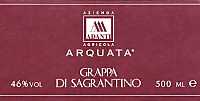
|
|
Grappa di Sagrantino |
|
| Adanti (Italy) | |
| (Distiller: Distillerie Aquileia) | |
| Raw matter: Pomace of Sagrantino | |
| Price: € 25.00 - 50cl | Score: |
| The grappa is colorless, limpid and crystalline. The nose denotes intense, clean and pleasing aromas of blackberry, hazelnut, licorice, black cherry and plum with almost imperceptible alcohol pungency. In the mouth is intense with evident alcohol pungency which tends to dissolve rapidly, good correspondence to the nose, pleasing sweet hint and good smoothness. The finish is persistent with flavors of black cherry, blackberry and licorice. This grappa is produced with discontinuous steam operated alembic still. Alcohol 46%. | |

|
|
Grappa di Nero d'Avola 2003 |
|
| Giovi (Italia) | |
| Raw matter: Pomace of Nero d'Avola | |
| Price: € 14.55 - 50cl | Score: |
| This grappa is colorless, limpid and crystalline. The nose reveals intense, clean, pleasing and refined aromas of plum, raspberry, black cherry, violet, blackberry and licorice with almost imperceptible alcohol pungency. In the mouth is intense with balanced alcohol pungency which tends to dissolve rapidly, good correspondence to the nose, pleasing and balanced sweet hits. The finish is persistent with flavors of plum, licorice and black cherry. This grappa is produced with a water bath discontinuous alembic still. Alcohol 42%. | |
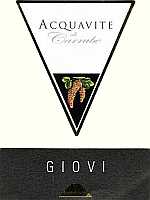
|
|
Acquavite di Carrube 2003 |
|
| Giovi (Italy) | |
| Raw matter: Carob | |
| Price: € 19.00 - 50cl | Score: |
| This brandy is colorless, limpid and crystalline. The nose denotes intense, clean and pleasing aromas of carob, tobacco, peach, hazelnut and chamomile. In the mouth is intense with alcohol pungency which tends to dissolve rapidly, good correspondence to the nose, good and pleasing sweet hint, pleasing roundness. The finish is persistent with flavors of carob and hazelnut. This brandy is produced with a water bath discontinuous alembic still. Alcohol 45%. | |
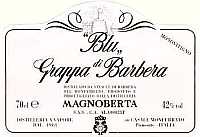
|
|
Grappa di Barbera “Blu” |
|
| Distilleria Magnoberta (Italy) | |
| Raw matter: Pomace of Barbera from Monferrato Casalese | |
| Price: € 14.50 - 70cl | Score: |
| This grappa is colorless, limpid and crystalline. The nose denotes intense, clean and pleasing aromas of cherry, raspberry, licorice and hazelnut with perceptible alcohol pungency. In the mouth is intense with evident alcohol pungency which however tends to dissolve rapidly, pleasing sweet hint, good roundness. The finish is persistent with flavors of raspberry and cherry. This grappa is produced with a discontinuous alembic still operating at low pressure. Alcohol 42%. | |

|
|
Grappa di Moscato “Rossa” |
|
| Distilleria Magnoberta (Italy) | |
| Raw matter: Pomace of Muscat Blanc from Canelli | |
| Price: € 17.00 - 70cl | Score: |
| This grappa is colorless, limpid and crystalline. The nose reveals intense, clean, pleasing and refined aromas of grape, peach, broom, rose, pear, hints of sage and almost imperceptible alcohol pungency. In the mouth is intense, with balanced alcohol pungency which tends to dissolve rapidly, good correspondence to the nose, good and pleasing sweet hints, agreeable smoothness. The finish is persistent with flavors of peach, pear and grape. This grappa is produced with a discontinuous alembic still operating at low pressure. Alcohol 42%. | |

|
|
Grappa di Dolcetto d'Acqui 1999 |
|
| Casa Luparia (Italy) | |
| Raw matter: Pomace of Dolcetto d'Acqui | |
| Price: € 16.50 - 50cl | Score: |
| This grappa is colorless, limpid and crystalline. The nose reveals intense, clean, pleasing and refined aromas of raspberry, cherry, cyclamen, rose and strawberry with almost imperceptible alcohol pungency. In the mouth is intense with balanced alcohol pungency which tends to dissolve rapidly, good correspondence to the nose, pleasing and balanced sweet hints, agreeable. The finish is persistent with flavors of raspberry, strawberry and cherry. A well made grappa. This grappa is produced with a discontinuous alembic still operating at low pressure. Alcohol 42%. | |
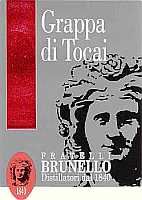
|
|
Grappa di Tocai 1999 |
|
| Fratelli Brunello (Italy) | |
| Raw matter: Pomace of Tocai Friulano | |
| Price: € 15.50 - 70cl | Score: |
| This grappa is colorless, limpid and crystalline. The nose denotes intense, clean and pleasing aromas of apple, almond, licorice and pear with almost imperceptible alcohol pungency. In the mouth is intense with balanced alcohol pungency which tends to dissolve rapidly, good and pleasing sweet hint, pleasing roundness. The finish is persistent with flavors of apple, almond and a pleasing sweet hint. This grappa is produced with a discontinuous steam operated alembic still. Alcohol 40%. | |
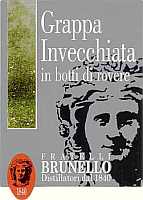
|
|
Grappa Invecchiata in Botti di Rovere 1998 |
|
| Fratelli Brunello (Italy) | |
| Raw matter: Pomace of Merlot, Cabernet, Corvina, Rondinella, Molinara | |
| Price: € 16.50 - 70cl | Score: |
| This grappa shows a pale golden yellow color and nuances of golden yellow, limpid and crystalline. The nose reveals intense, clean, pleasing and refined aromas of licorice, tobacco, vanilla, cinnamon, honey, hazelnut, prune, hints of rosemary and almost imperceptible alcohol pungency. In the mouth is intense, with balanced alcohol pungency which tends to dissolve rapidly, good correspondence to the nose, pleasing and balanced sweet hint, agreeable smoothness. The finish is persistent with flavors of licorice, honey, hazelnut and prune. A well made grappa produced with a discontinuous steam operated alembic still. It ages for about two years in Allier oak barriques. Alcohol 43%. | |
Wine Parade |
|
|
| The best 15 wines according to DiWineTaste's readers. To express your best three wines send us an E-mail or fill in the form available at our WEB site. |
| Rank | Wine, Producer | |
|---|---|---|
| 1 |
| Chablis Grand Cru Les Clos 2002, Domaine Billaud-Simon (France) |
| 2 |
| Harmonium 2001, Firriato (Italy) |
| 3 |
| Riesling Cuvée Frédéric Emile 1999, Maison Trimbach (France) |
| 4 |
| Jerez Fino Tio Pepe, Gonzalez Byass (Spain) |
| 5 |
| Palazzo della Torre 2000, Allegrini (Italy) |
| 6 |
| Montepulciano d'Abruzzo Villa Gemma 1999, Masciarelli (Italy) |
| 7 |
| Moscato d'Asti 2003, Vignaioli di S. Stefano (Italy) |
| 8 |
| Montepulciano d'Abruzzo Riparosso 2001, Illuminati (Italy) |
| 9 |
| Pinot Noir Napa 2002, Clos du Val (USA) |
| 10 |
| Edizione Cinque Autoctoni 2001, Farnese (Italy) |
| 11 |
| Aglianico del Vulture La Firma 2002, Cantine del Notaio (Italy) |
| 12 |
| Amarone della Valpolicella Classico 1998, Santa Sofia (Italy) |
| 13 |
| Riesling Spätlese Nierstein Brudersberg 2003, Weingut Freiherr Heyl Herrnsheim (Germany) |
| 14 |
| Turriga 1998, Argiolas (Italy) |
| 15 |
| Amarone della Valpolicella Classico Capitel Monte Olmi 1999, Tedeschi (Italy) |
| |||||||
Privacy Policy | |||||||


| Copyright © 2002-2024 Antonello Biancalana, DiWineTaste - All rights reserved |
| All rights reserved under international copyright conventions. No part of this publication and of this WEB site may be
reproduced or utilized in any form or by any means, electronic or mechanical, without permission in writing from DiWineTaste. |